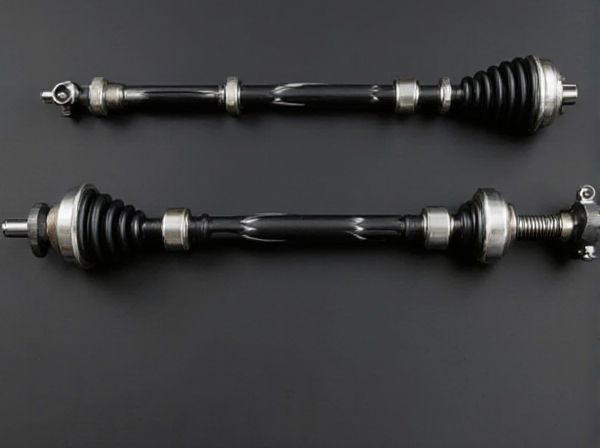
Photo illustration: Short Driveshaft vs Long Driveshaft
A short driveshaft offers increased rigidity and reduced weight, leading to better performance and less vibration, making it ideal for high-performance or compact vehicle setups. In contrast, a long driveshaft is necessary for vehicles with extended wheelbases, providing the needed length to connect the transmission and differential but potentially introducing more flex and vibration. Choosing the right driveshaft length ensures your vehicle operates smoothly without compromising power delivery or durability.
Table of Comparison
| Feature | Short Driveshaft | Long Driveshaft |
|---|---|---|
| Length | Typically under 24 inches | Typically over 24 inches |
| Weight | Lighter, less rotational mass | Heavier, increased rotational mass |
| Application | Sports cars, compact vehicles | Trucks, SUVs, long wheelbase cars |
| Performance | Improved acceleration, reduced vibration | Better torque handling at low RPM |
| Durability | Less prone to bending or twisting | Higher risk of flex and fatigue stress |
| Cost | Generally lower manufacturing cost | Higher cost due to material and design |
| Maintenance | Easier and quicker to service | Requires more frequent inspection |
Introduction to Driveshaft Lengths
Driveshaft length significantly influences vehicle performance and drivetrain efficiency, with short driveshafts offering reduced rotational mass and improved responsiveness, while long driveshafts provide necessary reach for larger vehicles or extended wheelbases. The choice between short and long driveshafts depends on the specific application, torque requirements, and space constraints within the vehicle chassis. Understanding the advantages and limitations of each driveshaft length is essential for optimizing power transfer and minimizing vibration in automotive and industrial machinery.
Key Differences Between Short and Long Driveshafts
Short driveshafts typically offer reduced rotational inertia, leading to quicker acceleration response and lower vibration levels compared to long driveshafts. Long driveshafts are designed to accommodate vehicles with greater distance between the transmission and the differential, often requiring additional support such as center bearings to prevent shaft whip and maintain stability. Material composition and diameter variations between short and long driveshafts also influence their torque capacity and overall durability under different driving conditions.
Benefits of a Short Driveshaft
A short driveshaft offers enhanced vehicle performance through reduced rotational mass, which improves acceleration and responsiveness. Its compact size minimizes the risk of vibrations and torsional stress, leading to increased durability and smoother power delivery. Short driveshafts also contribute to better ground clearance and easier installation in customized or performance vehicles.
Advantages of a Long Driveshaft
A long driveshaft offers enhanced torque transmission capabilities, improving power delivery to the wheels in heavy-duty vehicles and off-road applications. It provides greater flexibility in vehicle design, allowing for optimal placement of components and better weight distribution. The increased length also helps reduce vibrations and improve overall drivetrain smoothness, leading to a more comfortable driving experience.
Impact on Vehicle Performance
A short driveshaft generally enhances vehicle performance by reducing rotational mass and increasing drivetrain efficiency, leading to quicker acceleration and improved responsiveness. In contrast, a long driveshaft can introduce additional rotational inertia and potential vibrations, potentially diminishing power transfer efficiency and causing slight delays in throttle response. Optimizing driveshaft length based on vehicle design ensures balanced torque delivery and maintains drivetrain durability under varying load conditions.
Drivetrain Angles and Vibration Considerations
Short driveshafts generally maintain higher drivetrain angles, which can increase the likelihood of vibration due to more pronounced angular displacement between components. Long driveshafts allow for reduced drivetrain angles by positioning joints more favorably, enhancing smooth rotational motion and minimizing vibrations. Proper alignment and balancing of either driveshaft length are crucial to mitigate vibration issues and ensure optimal drivetrain performance.
Applications: When to Use Short vs Long Driveshafts
Short driveshafts are ideal for applications with limited space and higher rotational speeds, such as compact sports cars and motorcycles, due to their reduced weight and minimized vibration. Long driveshafts are better suited for larger vehicles like trucks, SUVs, and off-road vehicles where increased length is necessary to connect distant components while maintaining torque transmission. Selecting between short and long driveshafts depends on vehicle design requirements, drivetrain layout, and load capacity to ensure optimal performance and reliability.
Maintenance and Durability Factors
Short driveshafts generally require less maintenance due to reduced exposure to torsional stress and fewer joints susceptible to wear. Long driveshafts are more prone to vibrations and imbalances, necessitating regular inspections and lubrication to maintain durability. Material quality, usage conditions, and proper alignment significantly influence the longevity and performance of both short and long driveshafts.
Cost Implications and Replacement Tips
Short driveshafts typically cost less to manufacture and replace due to reduced material usage and simpler design, making them more budget-friendly for repairs. Long driveshafts often require specialized installation and may incur higher labor costs due to their complexity and increased risk of misalignment. When replacing any driveshaft, it is crucial to inspect for signs of wear such as vibrations or leaks, ensure proper balancing, and choose OEM or high-quality aftermarket parts to optimize longevity and performance.
Choosing the Right Driveshaft for Your Vehicle
Choosing between a short driveshaft and a long driveshaft depends on your vehicle's wheelbase and drivetrain layout, affecting performance and durability. Short driveshafts typically provide better rotational stability and less vibration, ideal for compact or performance vehicles, while long driveshafts are necessary for trucks or SUVs with extended frames. Ensure compatibility with your vehicle's torque requirements and consider materials like steel or aluminum to optimize strength and weight efficiency.
 caratoz.com
caratoz.com